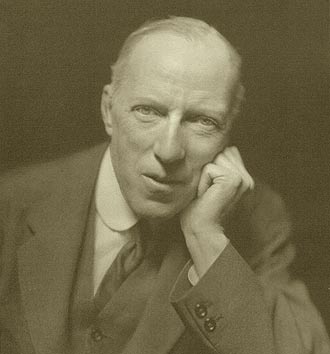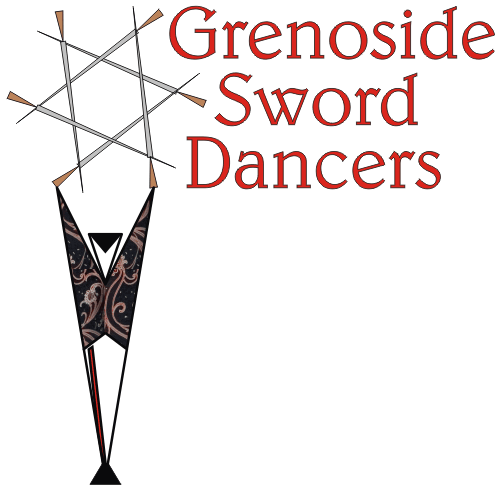| Cecil Sharp |

With the encouragement of the famous Gatty family, who hosted Cecil Sharp during his visit, and the English Folk Dance and Song Society, the Grenoside Sword Dancers reformed after both major conflicts in the 20th century and avoided the fate which befell other teams no longer in existence. The Grenoside Sword Dancers are still going strong, but we always welcome new members to perpetuate the tradition.
As part of the 2010 celebrations the team hosted the annual Sword Dance Union Competition, supported the Grenoside Summer Gala - organising a folk festival to rekindle the splendid events of the 1950s and 60s - and performed at the very barn where the dance was collected by Sharp on the 27th August 2010, exactly 100 years to the day. The team also collaborated with the Newcastle Kingsmen, local singers, musicians, artists and actors to develop a performance in homage to all four sword dances. It was not only a tribute to Sharp, but to sword dancers past and present, and the local people who keep alive the spirit of dance and community.
In 1907 Cecil Sharp had published his first collection of Morris Dances. He had first seen Morris Dancing at Christmas 1899 whilst staying with his wife's mother, who was then living at Sandfield Cottage, Headington, about a mile east of Oxford. On Boxing Day, as he was looking out of the window at the snow-covered drive, a strange procession appeared: eight men dressed in white, decorated with ribbons, with pads of small latten-bells strapped to their shins, carrying coloured sticks and white handkerchiefs. Accompanying them was a concertina-player and a man dressed as a 'Fool'.
Sharp was amazed at the sight. An obscure world of culture had been revealed to him and he plied the men eagerly with questions. They apologised for being out at Christmas; they knew that Whitsun was the proper time, but work was slack and they thought that there would be no harm in earning an honest penny. These were the Headington Quarry Morris Men.
Earlier in 1910 Sharp had been told of the existence of the Grenoside Sword Dance by the composer Ralph Vaughan Williams. Williams and Sharp had a mutual friend in Nicholas Comyn Gatty (1875-1946), who was a fellow composer and the music critic for the Pall Mall Gazette; an important periodical of the day which had, significantly, published an article on the visit of the Grenoside Sword Dancers to Wortley Hall in 1898.
He was educated at Downing College, Cambridge and at the Royal College of Music where he met and became a lifelong friend of Ralph Vaughan Williams, who from the 1900's spent many a summer vacation with the Gattys at Hooton Roberts. Nicholas pressed Sharp to contact his Aunt Horatia Eden. She was living in London and as well as being an author was a collector of mumming plays, a collection of which was published in 1948. Sharp went to see Horatia and she arranged for him to stay at the Rectory in Hooton Roberts with her brother (and the father of Nicholas), the Reverend Reginald Gatty. Hooton Roberts is 10 miles north-east of Grenoside.
Sharp came to Hooton Roberts on Friday, 26th August 1910 and on the following day was accompanied to Grenoside by Florence the wife of Reginald. They would certainly have passed through Ecclesfield, a mere 2 miles from Grenoside, and may have picked up other Gatty family members en route. The Reverend Dr Alfred Gatty (1813-1903) had been vicar of Ecclesfield from 1839 to his death. The Gattys of Ecclesfield were a highly cultured family of writers and musicians.
Grenoside is a small village, 6 miles north-west of Sheffield, on high ground with splendid views of the Dearne and Don Valleys. It lies on the edge of the industrial heartland of South Yorkshire and at the edge of the Peak District. In the 1840s it had a population of about 1,100 people (4,500 in 2000) who worked on the land, in quarries and in light engineering - nail making and file cutting. In 1850 it received the dubious honour of being given the "workhouse" for the parishes of Ecclesfield, Bradfield and Wortley; a stark reminder of the consequences of poverty! Before the development of railways it was on busy trade routes, being at the cross-roads of the coaching road from Sheffield to Halifax and the old salt routes from Cheshire. On the main street there still exist three pubs, The Angel, The Old Harrow and The Red Lion. These pubs would have given the team an opportunity to perform for beer, money and celebrity.
The Gattys had been long-term supporters of the sword dancers, both through their interest in local traditions and also as an act of philanthropy. During the 19th century the sword dancers were drawn from a small number of families whose menfolk worked in the local quarries. Quarrying was hard, low paid work that had long lay-offs in the winter months. Before the Great War the team consisted of a number of notable familes and their friends, in particular the Housleys, Coopers, Woods and Wraggs. The Housley dynasty can be traced from 1837 to this day.
During the Christmas period the Gattys had used their influence to arrange for the team to dance at local "big houses." At these events the dancers would be fed and treated to drinks and also receive a payment either as a fee or a collection. The dance would also be performed throughout the year if the opportunity arose.
Sharp had seen his first sword dance in Kirkby Malzeard near Ripon. The Kirkby Malzeard dance was performed by 6 dancers, a captain and a most splendid fool. The fool sported a huge "wide awake" hat, a halbard to ward off the encroaching crowd and a foxes tail. The dance was introduced by a splendid song entitled "Ye Noble Spectators".
Sharp travelled to Grenoside by horse and carriage, the Gattys having arranged for the performance to take place in the barn of Hilltop Farm at the top of Wheel Lane. It made a great impression on Sharp. He was particularly interested in the ritual slaying of the Captain/Fool and speculated in his book that this represented some previous human/animal ritual sacrifice or slaughter. The Grenoside dance was the most complex single dance that Sharp would see.
The dancers were by this time mainly coal miners and steel workers. They were probably accompanied by Walter "Mallock" Wragg on the flutina, a cheap and simple member of the accordion family.
Sharp returned to Hooton Roberts and after "an enjoyable weekend" took the train on Monday 28th August to Newcastle, in which area he collected the 'rapper' sword dances from Swalwell and Earsdon.
Sharp also travelled to the village of Abbots Bromley in Staffordshire to record the Horn Dance. This is an ancient dance performed with deer antlers but still alive and performed around the village each September accompanied by a large following.
Of the four sword dances collected, only the Grenoside team still exists. The dances from Kirkby Malzeard and Swalwell are currently performed by 'revival' teams although as of 2010 there were still living former Earsdon dancers who wrre being encouraged to teach the dance to a representative team so that it can be performed as the old team danced it.
The Grenoside Dance is also performed by the Newcastle Kingsmen, who were taught the dance by the Grenoside team in the 1950s. They have taken the essence of the dance and adapted in their own style. In terms of participation, sword and morris dancing is probably stronger today than it was when Sharp was collecting. This again is thanks to Sharp and his associates, in first collecting the dances and then promoting them at clubs and in schools. Today, the Sheffield area has a thriving folk dance scene.


